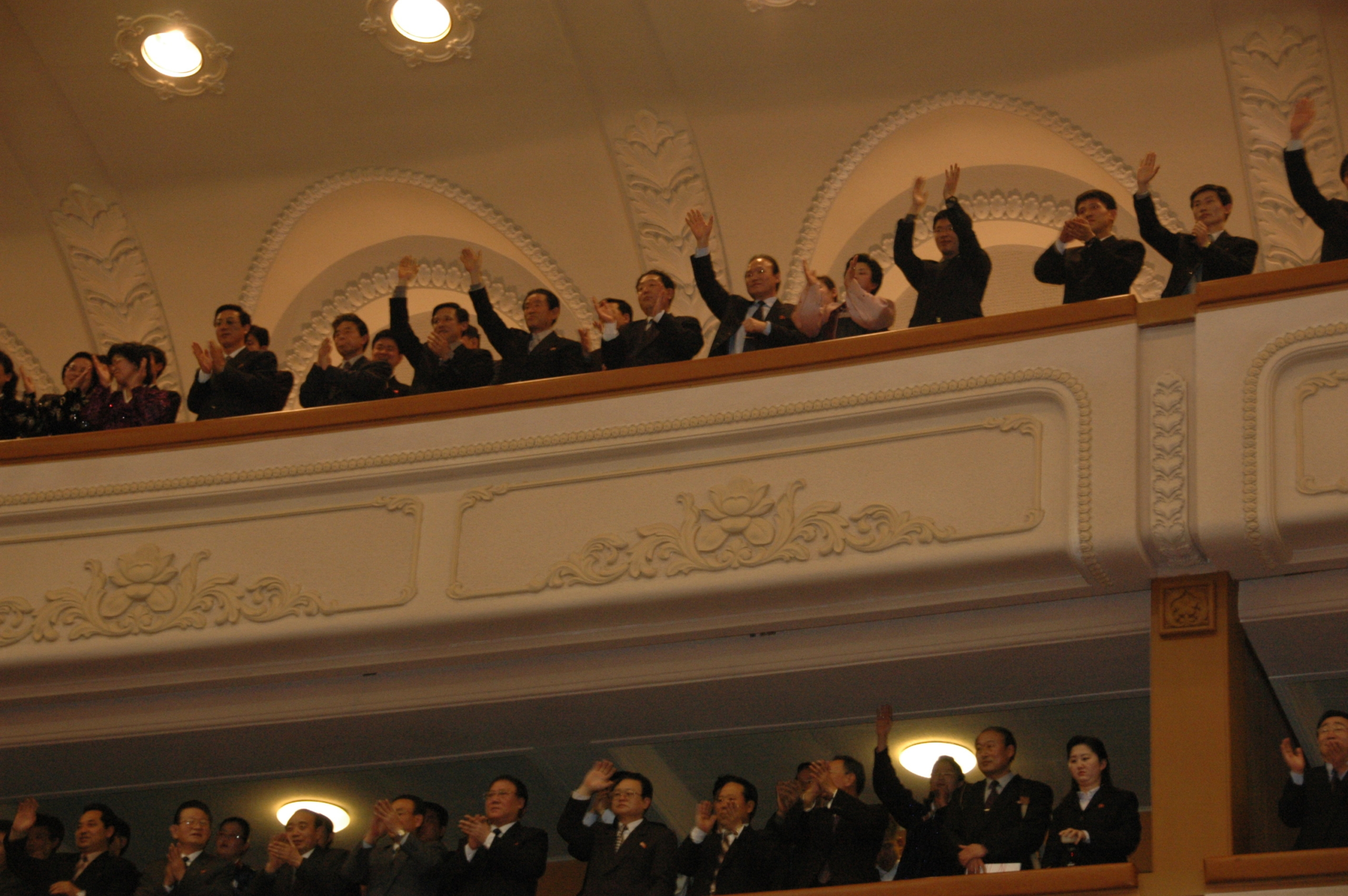The only sure thing about covering North Korea is this: The lead is always clear, the second sentence isn’t.
Over the past week, the latest twist in seven decades of inter-Korean conflict unfolded before thousands of journalists. After sharply accelerating its pursuit of nuclear weapons last year, North Korea seized an offer from South Korea to show a different side at the Winter Olympics, one of the globe’s biggest media events. It sent a handful of athletes, 229 cheerleaders, a music group, dozens of coaches and minders and Kim Yo Jong, the sister of dictator Kim Jong Un and the first member of the Kim family to ever visit South Korea.
ICYMI: Billionaires gone wild
And suddenly, the dominant narrative flipped. The tyrannical North Korean regime was…okay? But was it really? Was everyone, including the international media, being outsmarted? What was the regime really doing?
Critics pounced hard on news accounts that emphasized the positive reception and rosiest possible outcomes of North Korea’s emergence, however slight, from its shell. Going so far as to liken Kim Yo Jong to Ivanka Trump, some stories overlooked or downplayed the atrocities and confrontational nature of the North’s regime. On one level, that’s unsurprising because, for the reporters who closely follow North Korea, new developments are so rare that they naturally amplify them. And under the filing pressure of an event like the Olympics, reporters are thinking mostly about what they are seeing in the moment. Must they always remember and describe the awfulness of life for 25 million North Koreans?
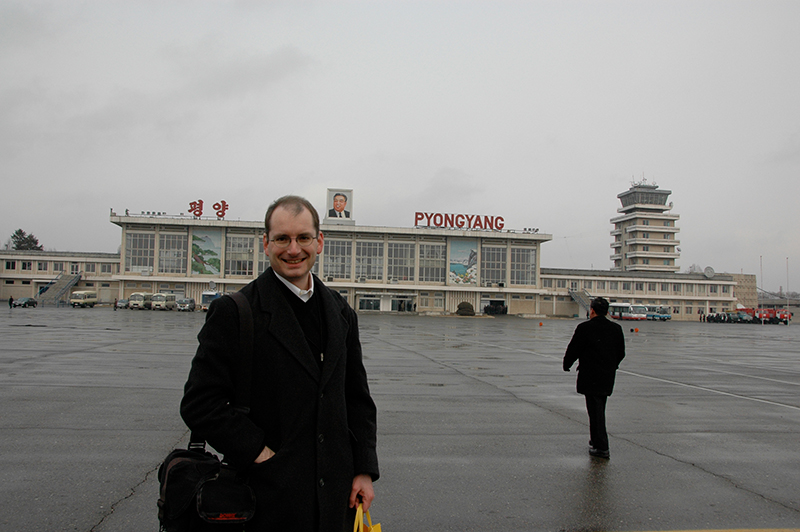
The author after landing in Pyongyang
As a Seoul-based reporter for The Wall Street Journal from 2006 to 2013, I frequently wrote about developments in North Korea and its relations with South Korea, the US, and others. I faced this dilemma ten years ago this month, when I was one of the 80 journalists who accompanied the New York Philharmonic to Pyongyang in another moment of goodwill. The visit was arranged by the State Department as a reward to North Korea for agreeing in early 2007 to halt its nuclear weapons program and an incentive to take more steps toward a lasting peace. Those steps didn’t happen and, today, the event has largely been forgotten. Amid the coverage of the North’s niceties in the South this past week, only The New York Times mentioned the Philharmonic’s trip.
I was one of 80 journalists who accompanied the New York Philharmonic to Pyongyang in 2008.
North Korea has been great at getting attention for many years, handily punching above its weight in the international media. On the surface, North Korea warrants it. Though it has given up communism as an ideology, power is still concentrated in its dictator, Kim Jong Un, grandson of founder Kim Il Sung. And it’s the only one of the old Soviet beneficiary countries that hasn’t reconciled with the United States. Yet the “final victory” the North Korean regime speaks of today is not the global spread of communism but unification of the Korean Peninsula on its terms. To advance its message and control its image, North Korea government combines outrageous behavior with draconian limits on media access. It also benefits from the willingness of competitive news organizations to lower their reporting standards in return for access to a place that is exotic, scary, bizarre and even entertaining. Unfortunately, often enough, it has been able to count on journalists’ shortcuts and short memories for some extra polishing of its reputation in the world.
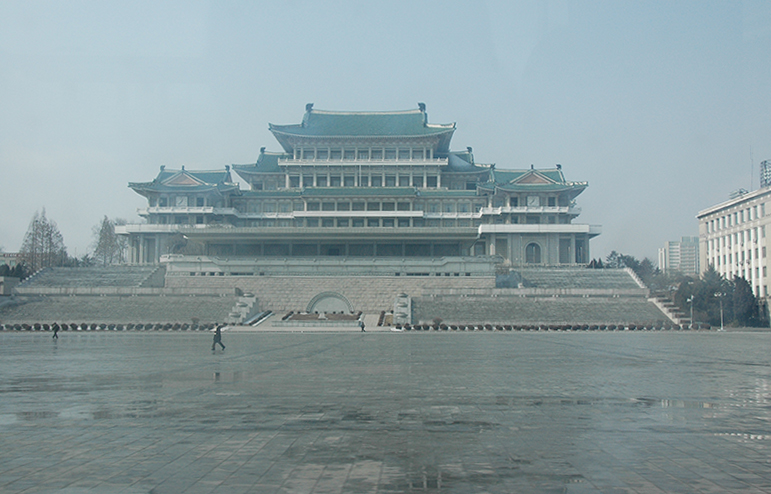
Kim Il Sung Square and the building where the North Korean leader overlooks parades
Marcus Noland, executive vice president at the Peterson Institute of International Economics and co-author of the influential “Witness to Transformation” blog about North Korea, last fall wrote a short essay arguing that media coverage of North Korea is “uncomfortably akin to writing fiction.” The country, he sayssaid, is small and not very important to most people—obscurity that’s compounded by the clamps the regime applies on foreign media access. “So when something happens, the nature of press coverage is framed by three basic points: It’s a strange place, it only receives periodic episodic attention, and the press has little conventional access. Under such conditions, journalists scramble for expert opinion,” Noland wrote.
Articles on North Korea’s intentions are typically derived from statements in its own media and then subjected to broad debate by experts with varying agendas. Kim Jong Un and others in the regime are never forced by North Korean reporters to explain or expand upon those statements. Diplomats rarely get the chance to interact with the regime. International reporters get less of a chance and those who do tend to walk away empty-handed. Evan Osnos, the New Yorker staff writer whose cover story last September was the best, most nuanced attempt by an American journalist to get at Pyongyang’s intentions in years, concluded by writing, “In eighteen years of reporting, I’ve never felt as much uncertainty at the end of a project, a feeling that nobody—not the diplomats, the strategists, or the scholars who have devoted their lives to the subject—is able to describe with confidence how the other side thinks.”
A decade ago, US diplomats and other interlocutors thought they had a better understanding of North Korea. The six-party talks progressed well through 2006 and led to an agreement in February 2007 under which North Korea would shut down a reactor producing fuel for nuclear weapons and get about a year’s worth of oil, worth about $250 million, from the US and other countries. By July, enough progress had been made that the Bush administration acknowledged it was exploring ways to forge a peace treaty to end the Korean War of the 1950s. And talks began to arrange the visit by the New York Philharmonic, the American orchestra that, in 1959, produced a breakthrough in Cold War relations during a three-week trip to the Soviet Union.
The press pack that accompanied Philharmonic was the largest group of American and Western journalists that North Korea had welcomed since a sports festival in the 1990s. It was the last time a foreign reporter would meet a high-ranking North Korean official—CNN’s Christiane Amanpour interviewed Kim Kye Gwan, the longtime chief negotiator in the six-party talks—until early 2017, when the AP and ABC were given interviews with a vice foreign minister.
The Philharmonic hoped the visit would repeat, in a fashion, the impact of its Soviet trip. But the Pyongyang affair was much shorter, just 40 hours and so tightly scheduled that it seemed unlikely to yield drama. Reporters mined small controversies for some: how the North Korean flag dwarfed the US one, how some North Korean musicians rehearsed with the orchestra for the concert but ultimately didn’t perform in it, and whether the top leader himself, Kim Jong Il, would attend.
Peter Landers, then an editor on the Journal’s Page One desk, flew from New York to help cover the visit and to teach me a new trick: blogging. The Philharmonic’s visit marked one of the first blogs the Journal created around a spot news event. Along with reporter Daniel Wakin and photographer Chang Lee, the Times sent a videographer, the first time I’d ever seen a newspaper with a dedicated video journalist. This gave the Times a huge advantage on us. I shot video for the Journal, the tape of which I FedEx’d to New York for editing when we were back in Seoul. Several journalists—Bay Fang of the Chicago Tribune, Bradley Martin of Bloomberg, Anna Fifield of the Financial Times, novelist Suki Kim—had been to North Korea before and drew comparisons from previous visits. With the exception of Kim, who was on assignment for Harper’s, none of the major news organizations sent Korean-speaking journalists. (I have no idea if any tried and were turned down by the organizers.)
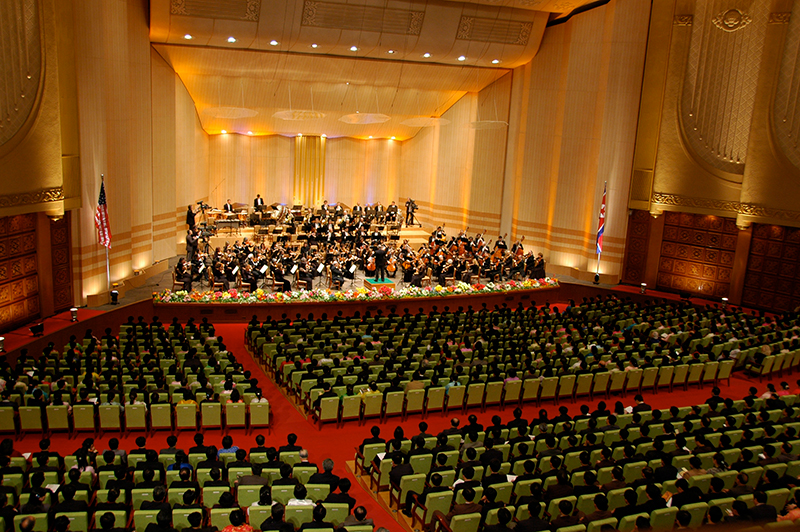
Rehearsal for the Philharmonic
On the morning of the concert, about half the journalists watched the Philharmonic rehearse while the other half went on the standard tour on which the North Korean government takes foreigners. They went to a subway station, a library, and the giant statues of Kim Il Sung and Kim Jong Il. In the afternoon, a North Korean cultural official spoke at a news conference but was unable to answer any questions about the broader relations between the country and the United States. All in all, the trip was shaping up to be rather predictable and uneventful.
But at the end of the concert, there was a moment of confusion when the audience began to sit down following three encores and three sessions of applause. Then, the musicians started to leave the stage. As audience members realized the concert was indeed over, they stood up again, clapped even louder, yelled bravos and waved. Orchestra members waved back.
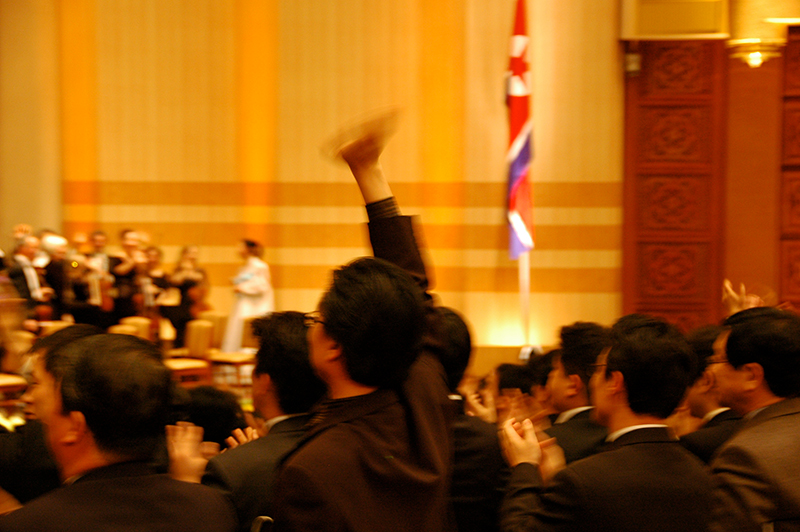
For five minutes.
We had a lead. Orchestra members who had left the stage, including conductor Lorin Maazel, came back. Reporters looked around in wonder. I started snapping pictures, many of them out-of-focus because it was darker in the audience than on the stage. I caught one of Fifield talking to a cheering North Korean woman. You can see much of the ovation on YouTube.
Backstage later, Maazel instantly believed the best, telling reporters he interpreted the audience as saying, “We understand the gesture of coming here. It could not have been easy for you. We appreciate that you did.” He says he thought the concert would do a great deal for relations between the two countries. “We may have been instrumental in opening a little door.”
The news accounts were enthusiastic, though not as over the top as Maazel. Peter and I hedged in our main article by writing that few diplomats thought the tour would produce a breakthrough. “But it was an exceptional moment for two nations mired in six decades of mistrust, with political and economic policies in direct opposition,” we wrote. In The Washington Post, Blaine Harden wrote, “The eruption of applause, which continued until nearly the entire orchestra had left the curtainless stage, seemed spontaneous and genuine. But events offstage throughout the day pointed to the undertow of strangeness, fakery, and fear that infects life in this country.” Fang, in the Tribune, wrote, “Even North Korean officials, who normally steer clear of expressing enthusiasm for the US, waxed effusive about the potential power of the program.” In the FT, Fifield wrote a four-word summary that I admired for its brevity: “It felt like history.”
ICYMI: 11 images that show how the Trump administration is failing at photography
But a decade later, I wonder: Were we gulled the way that some people think the reporters at the Winter Olympics have been duped by Kim Yo Jong and the North Korean cheerleaders?
Kim thinks so. In her article that Harper’s published a few months after the trip, she wrote that, up until the finale, “Everyone agreed that what they were allowed to see could not have been how things actually were.” She then added, “Yet their skepticism faltered when they considered music’s power to move the audience.” In a chat last month, she told me that she thought we were “unbelievably naïve” and reporters misunderstood much of what happened during the visit. Part of that was the language barrier, part was not having enough understanding of North Korea history and attitudes toward the US, and part, she says, was our starting place. Nearly all the reporters saw the event entirely through the prism of US-North Korea relations rather than trying to understand how it fit into the goals of the North Korean regime. “There is a weird blind spot when you think your country is the protagonist,” she says. “For the North Koreans, they are the protagonist. The blind spot makes you unable to see that.”
Martin, on his seventh trip to Pyongyang, also thinks there was less to the ovation than met the eye. “I assumed they had been told to provide an ovation,” he told me recently. The elites in the audience, he says, reminded him of the crowds he saw during Billy Graham’s visits to North Korea in the early 1990s. Jon Herskovitz, who covered the trip for Reuters, was judicious in the way of wire-service reporters. “It seemed for the most part genuine, but this is a country where people are demanded to applaud on cue,” he told me.
Harden says he believes the audience was moved and the ovation was genuine. “Music is an incredibly powerful emotional force that cuts through a lot of different things and it unites people in their humanity,” he says. “I just think a great orchestra touched the lives of every person in that room. The political meaning of it, I think, was nil.”
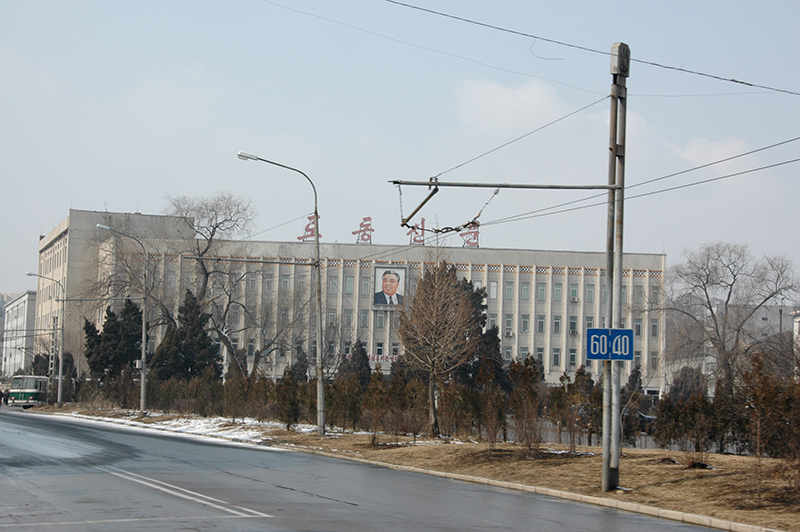
The office of Rodung Shinmun, North Korea’s largest newspaper, just a couple of blocks from Kim Il Sung Square
A few months after the trip, Harden began to systematically interview defectors for the Post, work that would ultimately lead him to the subject of his 2012 book Escape from Camp 14. Those interviews were laborious, taking days to get North Koreans to warm up to him and leading him to realize that the 40 hours in Pyongyang with the Philharmonic were almost meaningless. “The kind of country [defectors] described, this fear, eating the bark off trees, families who feared they were going to be put in camps or killed, just that sense of fear, suffering, hunger, none of that came through on that trip,” he told me. “That’s when I really started to feel like that trip was an abomination.”
Today, the Post’s correspondent for Japan and the Koreas is Fifield, who returned to the region in 2014 after six years in other countries for the FT. She is the only reporter from the Philharmonic trip who is also covering the current Winter Olympics in South Korea. “Even if they’re loyal to the regime, these are still human beings and I think they did respond to the music,” she told me in recalling the 2008 trip. Her last trip to North Korea, part of a small group of foreign journalists invited to cover a party congress in 2016, proved to be less restrictive than the 2008 visit. She could use her smartphone to tweet and produce a Facebook Live video, for instance. But that group of foreign journalists wasn’t actually allowed to see the party congress or meet with officials. Thailand, a main stopping point for North Korean defectors, today is the most effective place to get fresh news from the North, she says. “The emotion I experience on my way out of North Korea is just frustration,” Fifield says. “Frustration at being there and seeing little new, of being unable to see the things I want to see and get answers to the questions I want to get.”
The ovation surprised me and I remember wishing in that moment for Korean language fluency and more time to understand it. I portrayed it as the audience taking control of the event from the orchestra. On reflection, I think that represented a little-spoken belief reporters have about North Korea: that big change will happen there. So far, North Korea keeps proving us wrong.
[There is] a little-spoken belief reporters have about North Korea: that big change will happen there. So far, North Korea keeps proving us wrong.
Though they didn’t say it until considerably later, the interlocutors who handled the logistics of the Philharmonic trip had a discomforting meeting with North Korean officials just a few hours before the concert. The goodwill that built up through 2007 was already ebbing by early 2008. Suspicions that the country was developing uranium as a fuel for nuclear weapons were growing and would have to be dealt with, the group led by former Defense Secretary William Perry told the North Koreans. In August 2008, Kim Jong Il suffered a stroke. Nothing in the diplomatic activity was the same after that. The regime hunkered down while Kim recuperated and succession planning kicked into high gear, leading to the October 2010 public debut of Kim Jong Un. On the day after the US election in November 2008, Evans Revere, one of the former diplomats who helped arrange logistics of the Philharmonic trip, met a senior North Korean diplomat for dinner in New York City. Revere told the North Korean that Barack Obama, backed by a Democratic Congress, would be in a better position to continue progress toward a peace treaty. The North Korean did not respond positively. “He basically told me that the time for people like him and me was over,” Revere recalled recently.
The Philharmonic’s trip was a turning point after all, just not in the direction the Americans hoped. “In the context of the political and diplomatic relations of the two countries, the concert was an aberration,” Revere says.
Ten days after the trip, the Washington Post Magazine published a profile of Stephen Linton, an American doctor who grew up in South Korea and for years has led the fight against tuberculosis in North Korea. The piece was written by Stephen Glain, who preceded me as the Journal’s Seoul correspondent by more than a decade and at the time was writing for Newsweek and the Post. In contrast to the coverage of the Philharmonic’s trip—or even the recent flurry of Olympics-related stories involving North Korea—Glain’s article was born of a reporting relationship that developed over years and climaxed with a two-week trip accompanying Linton to parts of the country never seen by outside journalists. It is a detailed, complex portrait of doctors and patients working inside a system with immense constraints. Glain used none of the hyperbole usually associated with North Korea coverage. Glain told me recently that the “high drama of what it’s like to deal within that system” was enough. “Why embellish it?” Linton, he says, is an exceptional figure who glides between both Koreas. “He’s got the touch. He knows how to treat them,” Glain says. Beyond that, “He knows what he’s got on the table.”
Glain’s article about Linton is the exception that proves the rule about North Korean coverage. Its “second sentence,” its meaning, is clear largely because Glain had the raw material that journalists need to do their jobs well—on-the-ground access, a number of primary sources and time to sift truth from fakery. Nothing like it has appeared in an American newspaper, magazine or broadcast since.
ICYMI: The Wall Street Journal unleashes a bombshell report
Correction: Anna Fifield started at the Post in 2014, not 2016. The article has been updated to reflect this.
Evan Ramstad is a deputy business editor for the Star Tribune in Minneapolis. He worked previously for The Wall Street Journal in Dallas, Hong Kong and Seoul, the Associated Press in Minneapolis, Dallas, New York and Washington, the St. Paul Pioneer Press in St. Paul, Minnesota, and KGRN Radio in Grinnell, Iowa.

